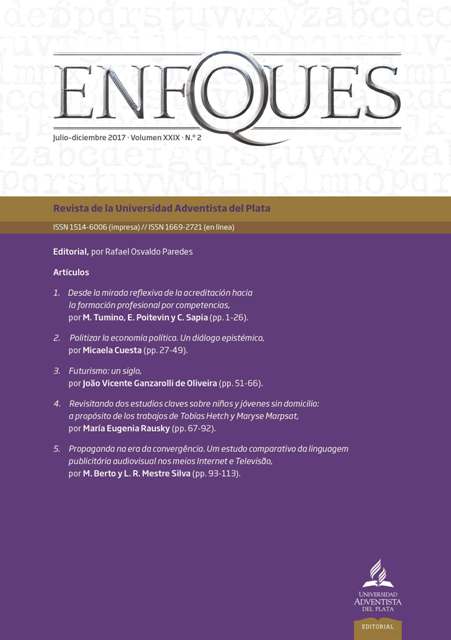Futurism: a century
DOI:
https://doi.org/10.56487/af4zb719Keywords:
Futurism, Modern art, Occidental culture, ContemporaneityAbstract
A little tempo ago, Futurism completed one century of existence. It has been the last
artistic movement that managed to gather under one banner all the major arts. In Futurism
– along with the other major genres of artistic expression of the xxth century,
particularly Dadaism and Surrealism – are the seeds of what we now call contemporary
art. This article aims to discuss some historical aspects of the futuristic eruption;
furthermore, it provides some critic basis for its fair evaluation.
Downloads
References
Dicionário de artes plásticas (Rio de Janeiro: Escola de Belas-Artes da UFRJ, 2005), 278.
Javier Itúrbide Díaz et al., Cuando las cosas hablan: la historia contada por cincuenta objetos de Navarra (Pamplona: Gobierno de Navarra, 2015), 11.
Otto Maria Carpeaux, Historia de la literatura occidental, vol. 7 (Río de Janeiro: Edições O Cruzeiro, 1966), 3058.
Santiago Prampolini. Historia universal de la literatura, trad. Dante Ponzanelli, vol. 9 (Buenos Aires: Uteha, 1941), 315.
Cf. Alberto Cesare Ambesi et al., Encyclopédie de l’art, trad. Béatrice Arnal et al. (Paris: Librairie Générale Française, 1991), 112.
Citado por Alberto Cesare Ambesi et al. en Ibíd., 913.
Cf. Udo Ulfkotte, Mekka Deutschland. Die stille Islamisierung (Rottenburg: Kopp Verlag, 2015), 49-52; y Bat Ye’or, Eurabia: l’axe euro-arabe (Paris: Jean-Cyrille Godefroy, 2014), 84, 87-88, 168.
Veáse Alberto Cesare Ambesi et al., Encyclopédie de l’art, 943.
Citado por Gerd Bornheim en O sentido e a máscara, 2.ª ed. (São Paulo: Perspectiva, 1969), 19.
Cf. Toby Clark, Art and propaganda in the Twentieth Century. The Political Image in the Age of Mass Culture (Londres: The Everyman Art Library, 1997), 81.
Otto Maria Carpeaux, Uma nova história da música, 2.ª ed. (Rio de Janeiro: José Olympio, 1967), 125.
Cf. H. W. Janson, História da arte, trad. Maria Manuela Rocheta Santos y J. A. Ferreira de Almeida (Lisboa: Calouste Gulbenkian, 1992), 686.
Cf. Fritz Baumgart, DuMont’s Kleine Kunstgeschichte (Colonia: DuMont, 1979), 314-315.
Cf. Veáse, en particular, Allgemeine Geschichte der Kunst: die Kunst des Mittelalters, trad. Ullrich Kuhirt et al., vol. 7 (Leipzig: Seemann, 1961).
C. K. Chesterton, Alarmas y digresiones, trad. Teresa Reyles, 2ª ed. (Buenos Aires: Espasa-Calpe, 1947), 70.
Cf., por ejemplo, Friedrich Nietzsche, Wille zur Macht (Stuttgart: Kröner, 1952), 734.
Veáse Baumgart, DuMont’s Kleine Kunstgeschichte, 307.
Veáse, Teófilo Urdánoz, Historia de la filosofía, vol. 6 (Madrid: Biblioteca de Autores Cristianos, 1978), 35-36, 51-54.
Veáse, Alberto Cesare Ambesi et al., Encyclopédie de l’art, 388-390; y Katja Fieder et al., Brockhaus, die Bibliothek: Kunst und Kultur, vol. 6 (Leipzig: Brockhaus, 1997), 74.
El mismo género de ironía domina las doscientas páginas que el crítico e historiador del arte francês Jean Clair escribió sobre el arte del siglo xx (cf. Considérations sur l’État des Beaux-Arts [Paris: Gallimard, 2008], 13).
Veánse las observaciones precisas de Hendrik Roelof Rookmaker en su inimitable ensayo Modern Art and the Death of Culture (Wheaton: Good News, 1994), 119-120.
Downloads
Published
Issue
Section
License
Copyright (c) 2019 Enfoques

This work is licensed under a Creative Commons Attribution-NonCommercial-ShareAlike 4.0 International License.





